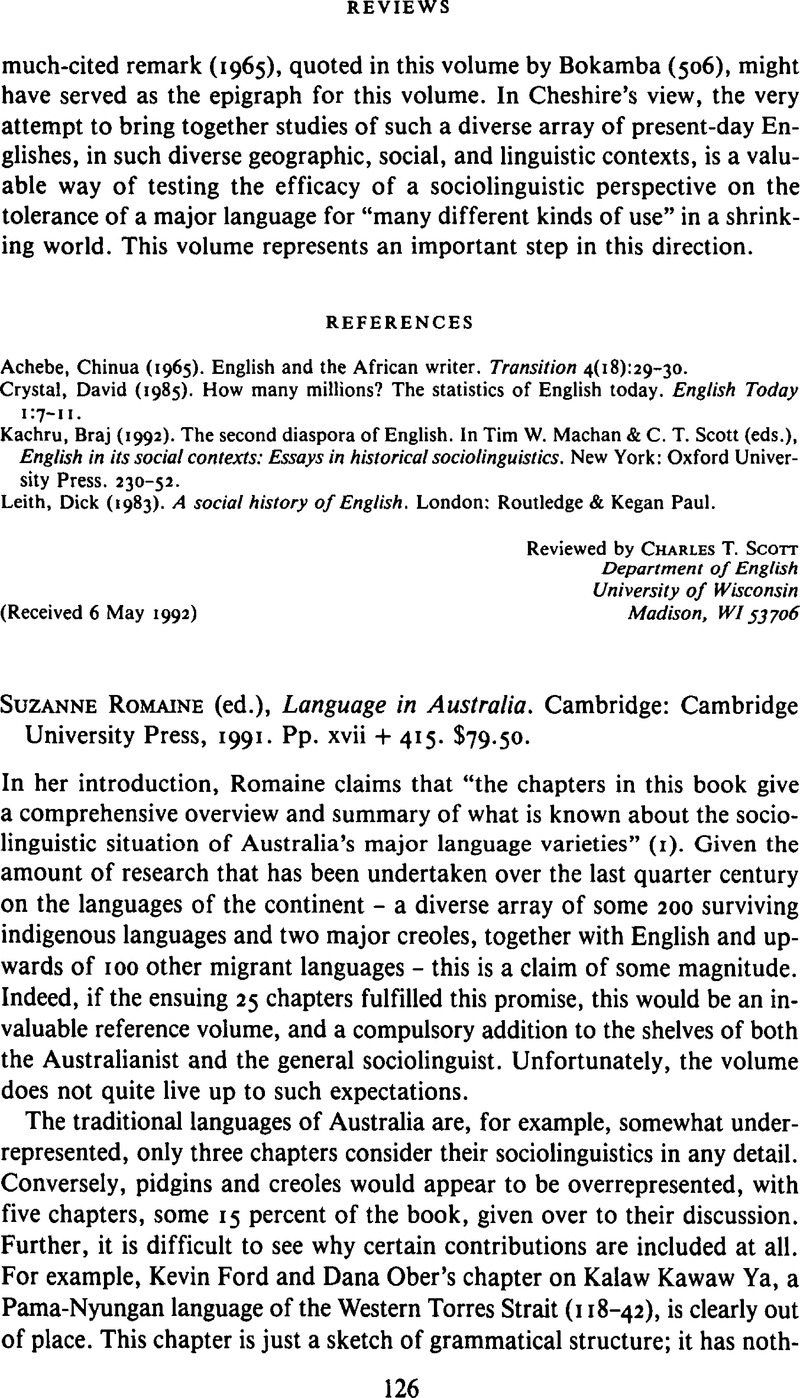No CrossRef data available.
Article contents
Suzanne Romaine (ed.), Language in Australia. Cambridge: Cambridge University Press, 1991. pp. xvii + 415. $79.50.
Published online by Cambridge University Press: 19 February 2009
Abstract
An abstract is not available for this content so a preview has been provided. Please use the Get access link above for information on how to access this content.

- Type
- Reviews
- Information
- Copyright
- Copyright © Cambridge University Press 1993
References
REFERENCES
Eades, Diana M. (1983). English as an Aboriginal language in South-east Queensland. Unpublished Ph.D. dissertation, University of Queensland.Google Scholar
Eades, Diana M. (1984). Misunderstanding Aboriginal English: The role of socio-cultural context. In McKay, G. R. & Sommer, B. A. (eds.), Further applications of linguistics to Australian Aboriginal contexts. Melbourne: Applied Linguistics Association of Australia. 24–33.Google Scholar
Eades, Diana M. (1985). You gotta know how to talk ⃛ Information seeking in South-east Queensland Aboriginal society. In Pride, John B. (ed.), Cross-cultural encounters: Communication and miscommunication. Melbourne: River Seine. 91–110.Google Scholar
Eades, Diana M. (1988). They don't speak an Aboriginal language, or do they? In Keen, Ian (ed.), Being Black: Aboriginal cultural continuity in settled Australia. Canberra: Aboriginal Studies Press. 97–116.Google Scholar
Harris, S. (1977). Beyond common sense in bilingual education. Brumby, E. & Vaszolyi, E. (eds.), In Language problems and Aboriginal education. Perth: Mt. Lawley College of Advanced Education. 116–38.Google Scholar
Harris, S. (1990). Two-way Aboriginal schooling – Education and cultural survival. Canberra: Aboriginal Studies Press.Google Scholar
Hudson, J. (1983). Transitivity and aspect in the Kriol verb. Papers in Pidgin and Creole Linguistics, No. 3. (Pacific Linguistics Series, A–65.) Canberra: Australian National University. 161–75.Google Scholar
McConvell, Patrick (1985). Domains and codeswitching among bilingual Aborigines. In Clyne, Michael G. (ed.) Australia - Meeting place of languages. (Pacific Linguistics Series, C–92.) Canberra: Australian National University. 95–125.Google Scholar
McConvell, Patrick (1986). Aboriginal language programmes and language maintenance in the Kimberley. Australian Review of Applied Linguistics S3:108–21.Google Scholar
McConvell, Patrick (1988). Mix-im up: Aboriginal codeswitching, old and new. In Heller, Monica (ed.), Codeswitching: Anthropological and linguistic perspectives. Berlin: Mouton de Gruyter. 97–124.CrossRefGoogle Scholar
Ramson, W. S., (ed.). (1988). The Australian national dictionary: A dictionary of Australianisms in historical perspective. Oxford: Oxford University Press.Google Scholar
Sandefur, John R., (1979). An Australian Creole in the Northern Territory: A description of Ngukurr-Bamyili dialects. (Working Papers of SIL-AAB, B3.) Darwin: Summer Institute of Linguistics.Google Scholar
Shnukal, Anna (1988). Broken: An introduction to the Creole language of Torres Strait. (Pacific Linguistics Series, C–107.) Canberra: Australian National University.Google Scholar


